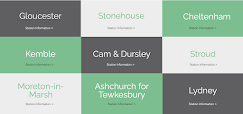Client Feedback - Where Next?
"Like the bright, eye-catching colour and curves of the simplistic style.
I particularly like your abstract pattern idea and both the colours and style could work well if done so that they are identifiable as the countryside.
1) I think I prefer the traditional fold method but that maybe because I’m not very good at visualising your initial idea (sorry, that probably doesn’t help much!).
2) While the colours don’t shout countryside to me they are eye-catching and look pleasing together.
3) I do think the map’s function would be to demonstrate the interesting places the walk goes through rather than just show which station follows another. The interest is in the walks and things people might see on the way.
4) Iconic representations of towns might work well although I don’t think there should be a mix of photographs and illustrations.
5) As mentioned earlier, I particularly like the abstract pattern idea and the colours. I wonder how easy (or difficult) it would be to produce an abstract that is also recognisable as the countryside?
6) That’s an interesting idea about the larger map on one side and then route maps on the other which could work well.
7) I think if sub routes are shown then colour coding is a very effective way of distinguishing one from the other."
From this feedback, I have decided that I will progress along the 'pipeline' of where I was initially heading with my ideas and inspiration. The client seems to be very interested by the use of pattern so this is something I will need to play with to see what balance of recognisability and abstract-ness they would be happy with. Before finalising an 'aesthetic' of an overarching visual language that represents the Rail Trails project, I must first have a clearer idea of a layout for the leaflet. This is crucial as the amount of space I give to each aspect that I include such as the maps and supporting type will determine stylistic choices based on scale and the hierarchy of the leaflet.
After receiving my client feedback, I will scrap the initial idea I had to fold the A3 page. Not only may it come off as hard to navigate when in a hurry, I am not too sure as to how it will hold up when mass printed on a low gsm paper before being creased or ripped.

Whilst a large variety of options are available to fold the A3 page, only a finite amount will work successfully as a consumable journey through the information necessary for all audiences to understand. For instance, having an eye-catching and bold map is crucial for this project which one of the gatefold folds would work perfectly for, opening up instantly to the map. However, these layouts could cause confusion in other places as pages you see at first before opening up to the map will now be on the back - it will take a lot of consideration to decide what information goes where in this example.
Overall, I believe that something similar to the 'Double Parallel' fold will work the best, This fold gives you a clear hierarchical order that a user will follow, featuring different panels that are opened to reveal the layer below - similar to the gatefold layout but with more, large panels to work with. To work well/be suitable for a rambler, It must also easily fit in a pocket or small bag so I may have to see if I could use this layout with a horizontal fold also to reduce the vertical height that would require the leaflet to be squished into pockets and bags.


Comments
Post a Comment